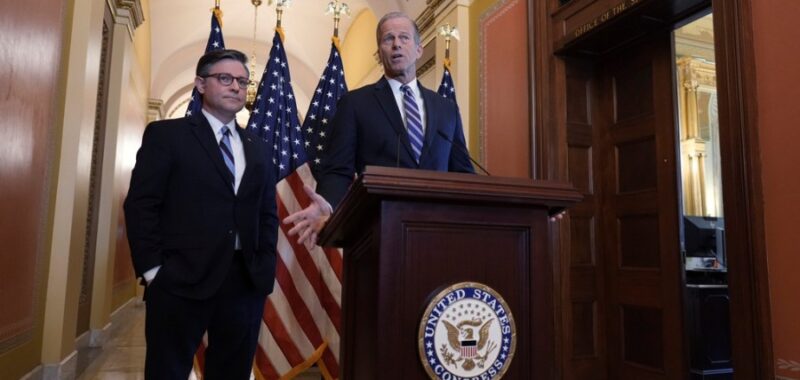
The congressional budget process is always open to fun and games. But just when you thought you have seen it all, an oldie but goodie reappears with a new cover and new twist that makes your head spin back to earlier times.
That’s what happened to me when I recognized a thinly disguised ploy in the current debate over budgetary savings — one that dates back nearly 47 years to the 1981 budget discussions over reconciliation in the first year of Ronald Reagan’s presidency.
Last week, the House and Senate came to a final deal on the concurrent budget resolution for fiscal 2025. It is more than six months overdue, but it is only the beginning of the process of enacting appropriations bills plus complying with reconciliation instructions on such weighty matters as taxes and entitlements.
The big demands the president is making in reconciliation is for Congress to extend expiring tax cuts for middle-income and upper-income taxpayers (plus adding a few new ones), providing more authority and funding for border security, and still reducing the deficit by considerable sums.
Pulling off these tax cuts without raising the deficit has become a game of legislative sleight-of-hand. The Senate did it by calling the extension of President Trump’s 2017 tax cuts part of the “current policy baseline,” thereby not causing a single penny of this $4 trillion expense to be added to the deficit. That tactic did not sit well with either the Senate parliamentarian or the score-keeping standards of the non-partisan Congressional Budget Office — neither of which disagreement inhibited the upper house.
Although the Senate finally cleared their budget resolution 51-48 late Saturday, April 5, after beating back a boatload of Democratic amendments, the measure ran up against an even bigger challenge in the House last week. There it faced a majority-defying group of around a dozen recalcitrant Republicans complaining the resolution, and especially the Senate’s tactics, do not comply with the president’s deficit reduction promises.
The dismal outlook for passage forced a day’s delay in House consideration as the Speaker feverishly worked to convert his conference skeptics to vote for the resolution. The challenge was made especially difficult by the variety of objections being raised by the GOP dissidents.
Moderates are wary of cuts that may reduce benefits for their constituents, whereas the more fiscally conservative members are anxious to find more areas for spending reductions.
The eventual compromise directed the House to achieve $1.5 trillion in savings over the next ten years, and the Senate to find only $400 billion. That difference provoked the rebellion among a dozen or so House fiscal conservatives which almost brought the whole scaffolding down.
It wasn’t until Senate Majority Leader John Thune (R-S.D.) assured the House that his ambition was to come closer to the House numbers, and Trump weighed-in behind the House version that sufficient Republicans converted to help narrowly pass the resolution, 216-214, with only two Republicans defecting.
In his memoir, “The Triumph of Politics: The Inside Story of the Reagan Revolution” (1986), Reagan budget director David Stockman recounted how, in Reagan’s first months in office, he struggled to patch together a budget that met all the president’s campaign promises: cut taxes, increase defense spending and balance the budget by 1984 (sound familiar?).
As the deadline approached for presenting that first budget in mid-February 1981, Stockman and his OMB shop were still coming up short by close to a half-trillion dollars over ten years. The final gauntlet was the Senate’s top Republican leadership members: Senate Finance Chairman Bob Dole (R-Kan.), who was leery of the proposed Kemp-Roth tax cuts; Senate Budget Committee Chairman Pete Domenici (R-N.M.), who was equally skeptical of supply side economics; and Senate Majority Leader Howard Baker (R-Tenn.), who was cast in the role of pronouncing the final word.
The major hangup was the part of the budget that did not specify where the savings would come from in the out-years — some $44 billion that were simply labeled, “future savings to be proposed.”
Finally, Baker “cleared his throat” and said: “Gentlemen, I am tempted to designate this $44 billion with a magic asterisk, but I won’t.” But then, after a pause, Baker added, “But, come to think of it, that’s our only choice. And so I will.”
Thus, the “magic asterisk” was born, to live alongside such other budgetary aphorisms of the era as “rosy Scenario,” and “smoke-and-mirrors.”
Today’s budget fixes are even simpler. Instead of declaring the renewal of Trump’s $4 trillion in tax cuts a deficit increase, pretend it is a continuation of “the current policy baseline,” thereby costing nothing.
And, instead of identifying where the $880 billion in savings the House Energy and Commerce Committee is instructed to produce, pretend that doesn’t mean having to cut into Medicaid, even if that’s only the pot big enough to draw on under the committee’s jurisdiction.
Budget resolutions are an expansive field for cattle to wander and fertilize. But the hard realities lie ahead when the cattle come home for the slaughter.
Don Wolfensberger is a 28-year congressional staff veteran culminating as chief-of-staff of the House Rules Committee in 1995. He is author of “Congress and the People: Deliberative Democracy on Trial” (2000), and, “Changing Cultures in Congress: From Fair Plays to Power Plays” (2018).

